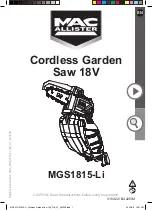
EN
14
4.1 USING THE MACHINE AS A MITRE SAW (Fig. 7 –
8 – 14)
– Release the head, by unscrewing the block pin
4
and
block rear end of stroke radial movement using the knob
3
.
– Raise the machine head as far as possible.
– Secure the work piece fi rmly against the angular bearings
of the base with your left hand, thus ensuring absolute
immobility during cutting.
– Put your right hand on the handgrip
1
and press the
button
8
in order to release the head.
– Activate the motor by pressing the start button
I (7 – Fig.
14)
on the handgrip.
– Lower the head and gradually bring the blade into contact
with the work piece.
– Complete cutting and raise the head to its original
position.
– Turn off the motor by pressing the button
0 (7-Fig. 14)
.
4.1.1 CORRECT USE OF THE SLIDING DEVICE
Note: it can be dangerous to cut pulling the head towards
you: the disk could “climb” in the material and raise towards
yourself. Always push the disk in the opposite direction,
away from you, when you slide–cut. The following points
describe how to slide–cut correctly:
1. Place the piece on the base of the mitre saw, against
the cut–end guide. Hold the operating handle, without
pressing the trigger.
2. Pull the arm towards you, keeping the arm in the upper
position. Then press the trigger to start the machine.
3. Push the protection
8 - Fig.14
locking button and push
the operating handle.
4. Push the arm towards the cut–end guide, to complete
the cut.
5. Release the trigger and keep the arm down until the disk
comes to a complete stop.
6. Once the disk stops, lift the head in its higher position.
4.2 USE AS A CIRCULAR SAW (cutting on the upper
work surface) (Fig. 7-11-15-21)
WARNING: Before starting any operation on the
work surface, check that the head is correctly
blocked in the lowered position, and pushed
against the back stop limit of sliding bars.
WARNING: When working on the upper surface, it
is absolutely necessary to install the lower safety
guard supplied (par. 3.3).
WARNING: The machine is equipped with a pusher
17 the dimensions and shape of which are in
compliance with the Safety Standards
When the machine is used as DISK SAW
(thus using the upper table for the machining
operations), such fi tting MUST ABSOLUTELY be
used.
Hold pusher from side A while side B, equipped
with different steps to match different thickness
sizes, must be put in contact with the piece to be
cut as shown in the fi gure 15.
The piece to be cut can be pushed by means of the
pusher which simultaneously drives and rest it on
square C (Fig. 23), thus enabling to keep hands
away from the blade cutting area.
WARNING: that the riving knife shall not be thicker
than the width of the groove cut by the saw blade
and not thinner than the body of the blade.
– When the motor is off, block the sliding movement to
the back stop limit of sliding bars using knob
3 - Fig. 7
,
lower the head of the machine and block it using lock
pin
4 - Fig. 20
.
– Adjust the height of the upper work surface according to
the cutting height desired and adjust the bearing bracket
as described in the
paragraph 3.3
.
– Check that the removable upper shield is not faulty: after
having lifted it slightly, it must return to its orginal position,
covering the blade completely.
– Activate the motor by pressing the start button
I (7 - Fig.
14)
on the handgrip.
– Place the work piece to be cut on the work surface,
placing it laterally against the bracket and then move
the work piece slowly and gradually towards the blade.
CAUTION: The work piece must always be held
fi rmly, paying attention not to hold it near the
cutting area.
– Turn off the motor by pressing the button
0 (7 - Fig.
14)
.
WARNING: after fi nishing working always put the
blade at 0 height position (Fig. 11).
5
ACCESSORIES
WARNING: Before carrying out the following
operations, the operator and/or authorized
maintenance technicians must make sure that the
machine has been turned off and is disconnected
from the power supply.
5.1 ASSEMBLY AND ADJUSTMENT OF THE
VERTICAL CLAMP (Fig. 24)
CAUTION: When cutting bars or pieces of
aluminium or plastic, use of the clamp is advisable
to hold the piece firmly against the angular
bearings, thus avoid¬ing movement during cutting
and, therefore, jams which could damage both the
workpiece and the blade.
















































